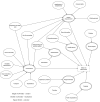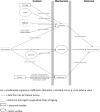Access to primary care for socio-economically disadvantaged older people in rural areas: exploring realist theory using structural equation modelling in a linked dataset
- PMID: 29914411
- PMCID: PMC6006834
- DOI: 10.1186/s12874-018-0514-x
Access to primary care for socio-economically disadvantaged older people in rural areas: exploring realist theory using structural equation modelling in a linked dataset
Abstract
Background: Realist approaches seek to answer questions such as 'how?', 'why?', 'for whom?', 'in what circumstances?' and 'to what extent?' interventions 'work' using context-mechanism-outcome (CMO) configurations. Quantitative methods are not well-established in realist approaches, but structural equation modelling (SEM) may be useful to explore CMO configurations. Our aim was to assess the feasibility and appropriateness of SEM to explore CMO configurations and, if appropriate, make recommendations based on our access to primary care research. Our specific objectives were to map variables from two large population datasets to CMO configurations from our realist review looking at access to primary care, generate latent variables where needed, and use SEM to quantitatively test the CMO configurations.
Methods: A linked dataset was created by merging individual patient data from the English Longitudinal Study of Ageing and practice data from the GP Patient Survey. Patients registered in rural practices and who were in the highest deprivation tertile were included. Three latent variables were defined using confirmatory factor analysis. SEM was used to explore the nine full CMOs. All models were estimated using robust maximum likelihoods and accounted for clustering at practice level. Ordinal variables were treated as continuous to ensure convergence.
Results: We successfully explored our CMO configurations, but analysis was limited because of data availability. Two hundred seventy-six participants were included. We found a statistically significant direct (context to outcome) or indirect effect (context to outcome via mechanism) for two of nine CMOs. The strongest association was between 'ease of getting through to the surgery' and 'being able to get an appointment' with an indirect mediated effect through convenience (proportion of the indirect effect of the total was 21%). Healthcare experience was not directly associated with getting an appointment, but there was a statistically significant indirect effect through convenience (53% mediated effect). Model fit indices showed adequate fit.
Conclusions: SEM allowed quantification of CMO configurations and could complement other qualitative and quantitative techniques in realist evaluations to support inferences about strengths of relationships. Future research exploring CMO configurations with SEM should aim to collect, preferably continuous, primary data.
Conflict of interest statement
Ethics approval and consent to participate
The London Multicentre Research Ethics Committee granted ethical approval for the ELSA (MREC/01/2/91), and informed written consent was obtained from all participants.
Competing interests
The authors declare that they have no competing interests.
Publisher’s Note
Springer Nature remains neutral with regard to jurisdictional claims in published maps and institutional affiliations.
Figures
Similar articles
-
Improving primary care Access in Context and Theory (I-ACT trial): a theory-informed randomised cluster feasibility trial using a realist perspective.Trials. 2019 Apr 4;20(1):193. doi: 10.1186/s13063-019-3299-2. Trials. 2019. PMID: 30947737 Free PMC article.
-
Folic acid supplementation and malaria susceptibility and severity among people taking antifolate antimalarial drugs in endemic areas.Cochrane Database Syst Rev. 2022 Feb 1;2(2022):CD014217. doi: 10.1002/14651858.CD014217. Cochrane Database Syst Rev. 2022. PMID: 36321557 Free PMC article.
-
Beyond the black stump: rapid reviews of health research issues affecting regional, rural and remote Australia.Med J Aust. 2020 Dec;213 Suppl 11:S3-S32.e1. doi: 10.5694/mja2.50881. Med J Aust. 2020. PMID: 33314144
-
Access to primary care for socioeconomically disadvantaged older people in rural areas: a realist review.BMJ Open. 2016 May 17;6(5):e010652. doi: 10.1136/bmjopen-2015-010652. BMJ Open. 2016. PMID: 27188809 Free PMC article. Review.
-
A realist review of which advocacy interventions work for which abused women under what circumstances.Cochrane Database Syst Rev. 2019 Jun 29;6(6):CD013135. doi: 10.1002/14651858.CD013135.pub2. Cochrane Database Syst Rev. 2019. PMID: 31254283 Free PMC article.
Cited by
-
Programme theory and realist evaluation of the 'Smoke-Free Vocational Schools' research and intervention project: a study protocol.BMJ Open. 2021 Feb 4;11(2):e042728. doi: 10.1136/bmjopen-2020-042728. BMJ Open. 2021. PMID: 33542044 Free PMC article.
-
Availability and Accessibility of Primary Care for the Remote, Rural, and Poor Population of Indonesia.Front Public Health. 2021 Sep 21;9:721886. doi: 10.3389/fpubh.2021.721886. eCollection 2021. Front Public Health. 2021. PMID: 34621720 Free PMC article.
-
Improving primary care Access in Context and Theory (I-ACT trial): a theory-informed randomised cluster feasibility trial using a realist perspective.Trials. 2019 Apr 4;20(1):193. doi: 10.1186/s13063-019-3299-2. Trials. 2019. PMID: 30947737 Free PMC article.
-
Serious Gaming During Multidisciplinary Rehabilitation for Patients With Chronic Pain or Fatigue Symptoms: Mixed Methods Design of a Realist Process Evaluation.J Med Internet Res. 2020 Mar 9;22(3):e14766. doi: 10.2196/14766. J Med Internet Res. 2020. PMID: 32149720 Free PMC article.
References
-
- Pawson R, Tilley N. Changes. 1997. Realist evaluation.
-
- Pawson R. Evidence-based policy: a realist perspective. London: SAGE Publications Ltd; 2006.
Publication types
MeSH terms
Grants and funding
LinkOut - more resources
Full Text Sources
Other Literature Sources
Medical



